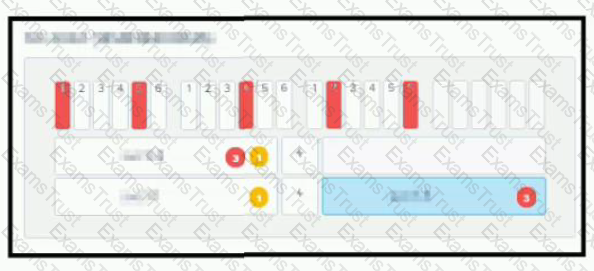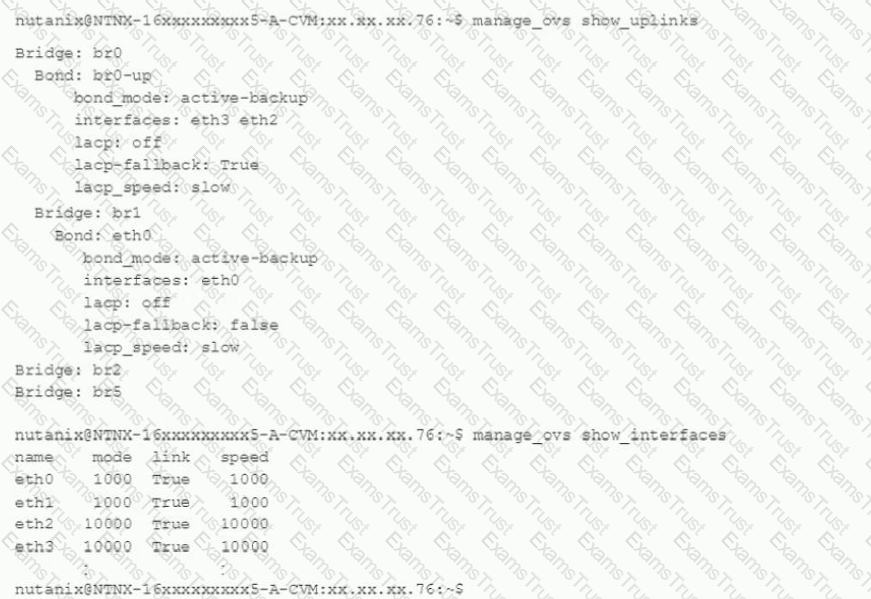A customer recently set up Async Replication between Site A and Site B. The customer wants to conduct a planned failover and clicks Activate on Site B.
The customer then runs the following command on Site A:
ncli pd deactivate_and__destroy_vms name=
What does this do to the customer environment?
Which Component Allows you to pair sites for disaster Recovery Policy Creation Using Nutanix Leap?
An organization is planning an upgrade to AOS 5.15 and wants to understand which cluster products and/or services are supported for physical traffic isolation.
Which Nutanix component supports its network traffic being isolated onto its own virtual network?
A systems administrator configures a protection domain replication between two Nutanix clusters. After the first successful replication, the administrator tests DR by clicking activate on the remote cluster.
While VMs are active on the remote cluster, the protection domain is marked as active on both clusters.
What steps are required to return both clusters to their original state?
A customer has a primary datacenter with 12 Nutanix blocks distributed across three racks. The customer wants to achieve the most resiliency possible. They also have a datacenter in a branch office that is 400 kilometers away from the primary datacenter.
Which two solutions should be used? (Choose two.)
In an AHV cluster, an administrator needs to enable an application to share a disk b group but needs to enable the VMs to see the volume group.
How should the administrator accomplish this task?
Refer to the exhibit.

An administrator logs in to Prism and sees the status shown in the exhibit within the Hardware Diagram section.
What should the administrator do?
An administrator has been tasked with delivering a report on all nutanix Field Advisors (FAs) Affecting each of the clusters.
What is the most efficient way to collect this data?
Which command should an administrator run from the CLI to view the uplink state of all AHV nodes in the cluster?
An administrator finds that home shares cannot be configured in a new Files 3.5 deployment. Why is this happening?
An administrator inherits a new Nutanix environment and logs in to a CVM to check the network configuration. The configuration is as follows:

Which action should the administrator take to improve network performance?
The following critical Availability Alert displays in prism Central:

The protection Policy PP-BCA-1HR includes a business critical application with a 1-hour snapshot frequency.
What is causing this issue?
An administrator is currently using both 10g uplink with LACP and balance-tcp. A single VM should not be allowed to use more than a single 10G uplink, and both uplinks should be utilized.
Which two command should be used to configure the bond? (choose two)
An administrator receives an error indicating that the CVMs in the cluster are not syncing to any NTP servers. An investigation of the issue finds:
• The NTP servers are configured in Prism
• The time on all CVMs is the same
• Both the CVMs and AHV hosts are configured for the UTC time zone
Which two steps can be taken to troubleshoot this issue? (Choose two.)
Which statement best defines Replication factor 2 (RF2 ) ?
An administrator is managing two AHV and vSphere-Based Clusters. The administrator is able to install a Windows Guest OS from an ISO Image to VMWare VMs , but is unable to do the same activity with AHV VMs.
What should the administrator do to successfully perform this action with AHV VMs?
An administrator needs to upgrade AOS for an air gapped cluster by using Prism Element.
Which two actions allow the administrator to perform the upgrade? Choose Two
An administrator receives a notification that storage in a Nutanix cluster is unavailable. The cluster consists of five nodes and is configured with a Fault-Tolerance level of 1 (FT-1).
Upon investigation, the administrator finds the following:
• All AHV hosts are powered on and the CVMs are running
• Nodes A, B, and C are connected to one top of rack switch
• Nodes D and E are connected to a second top of rack switch
• The cluster status command run on Node A shows that CVM services on nodes D and E are down
Which issue is causing the storage outage?
A company needs to replicate their VMs to a remote site and must have an RPO of less than 1 hour.
When creating a protection domain, what should an administrator do to meet this requirement?
An administrator is deploying a new application to a Nutanix Enterprise Cloud. The application requires a security to prevent unauthorized access. The application also uses many non-standard ports that are unique to it. Security should not be changed for existing applications.
What should the administrator do to meet these requirement?
A customer has Metro Availability configured in Automatic Resume Mode between Site A and Site B What happens to VMs if Primary Site A has full network failure?
When Does AOS automatically Generate a case with nutanix Support?
An administrator is implementing a VDI solution. The workload will be a series of persistent desktops in a dedicated storage container within a four-node cluster. Storage optimizations should be set on the dedicated storage container to give optimal performance including during a node failure event.
Which storage optimizations should the administrator set to meet the requirements?
An administrator is deploying several new application VMs to a Nutanix cluster. The application is very transactional with a 28/72 random, read/write ratio.
What should the administrator do?
A VM is exhibiting one or more of the following baseline values based on the past 30 days:
• CPU usage < 20%
• CPU ready time < 5%
• Memory usage < 50% (moderately) or < 20% (severely)
• Memory swap rate = 0 Kbps
Which type of VM is being described?